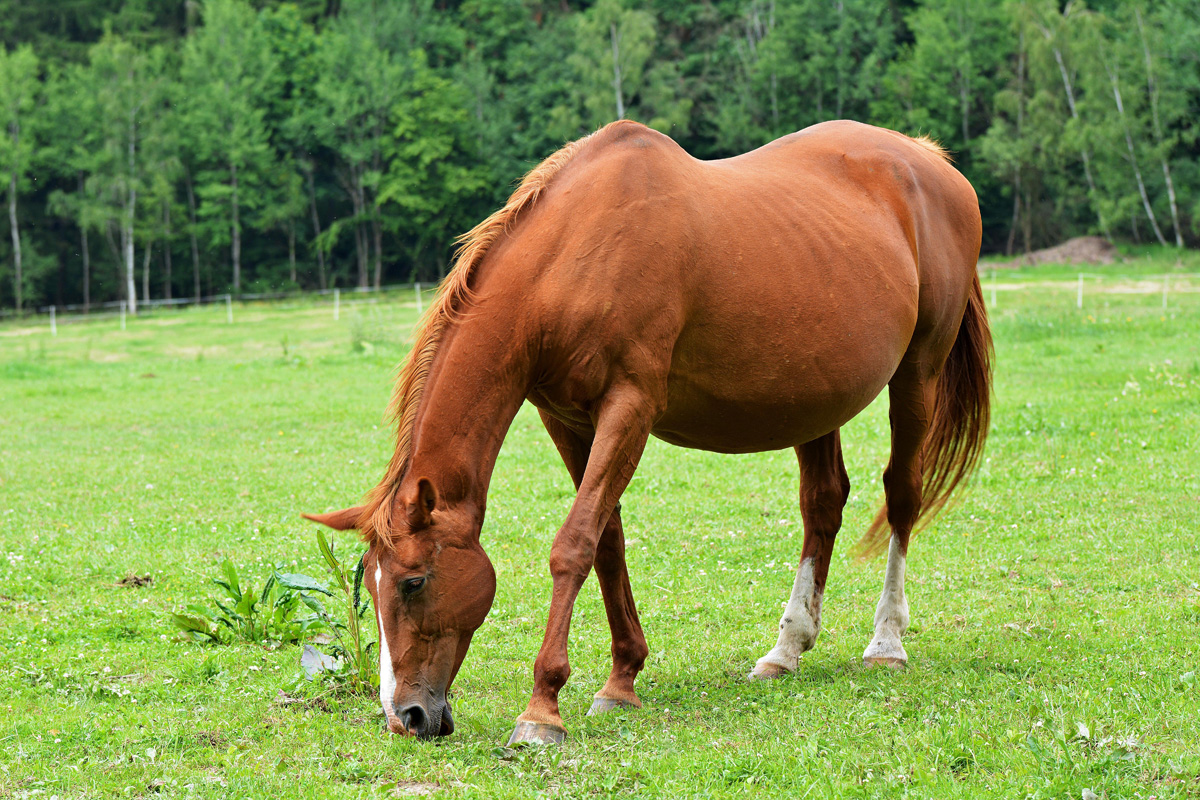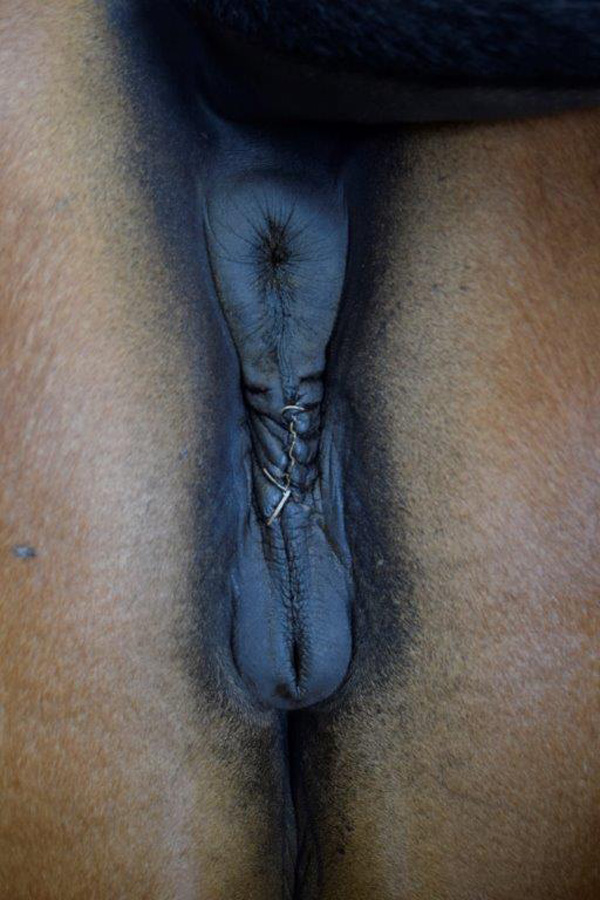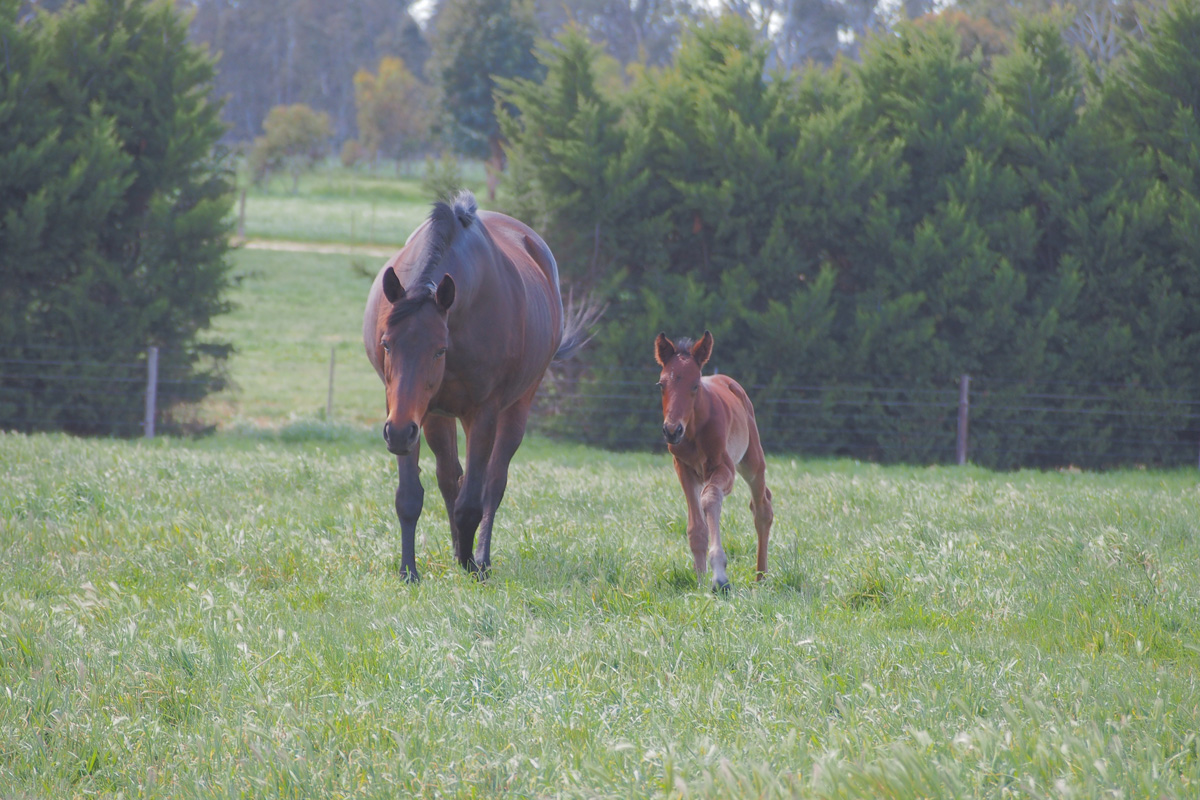Mares can have difficulties becoming pregnant for many reasons, and one of the more reported reasons is endometritis – an inflammation or infection of the endometrium, which is the lining of the uterus.
Endometritis can occur for a variety of reasons and in mares of all ages. Older mares and mares that have experienced a difficult foaling become increasingly vulnerable to endometritis as they age, and their natural immune defences start to decline.
Most mares that are bred will have incidences of endometritis as it often occurs after a mare is covered due to the introduction of sperm into the uterus. This is seen with both artificial insemination and natural cover. It happens because the uterus reacts to the introduction of foreign material into its environment and mounts an immunological response to rectify the intrusion. In “normal” mares, this response is short-lived and very effective, with the uterine environment quickly returned to its quiescent state, ready to accept and nurture an embryo should fertilisation occur. In some mares, however, the inflammation that is induced does not self-rectify and the mare continues to show signs of endometritis, a condition referred to as Persistent Breeding Induced Endometritis (PBIE). This is seen clinically as fluid in the uterus when the mare is examined with the ultrasound.
“Endometritis can occur for a variety
of reasons and in mares of all ages.”

When a mare develops PBIE, several outcomes can occur. The mare may resolve the endometritis on her own, using her innate immunological and physical defences to clear the uterine environment. If unable to clear the endometritis, the inflammation becomes well established and the mare develops chronic endometritis, and this can cause further damage leading to permanent changes in the lining of the uterus. The uterus can also become contaminated with bacteria during these episodes of endometritis and develop an acute infectious endometritis, which if not treated correctly, becomes a chronic infectious endometritis. Mares with chronic infectious endometritis become bad breeders because they are persistently plagued with fluid in their uterus. These mares require intensive treatment and management to become pregnant and carry a pregnancy to term.
INNATE DEFENCE MECHANISMS
When a mare is initially covered, the sperm cells and associated products are recognised as foreign. The body then mounts an immunological response to deal with this foreign intrusion and eliminate any excess sperm, seminal fluid, debris, or bacteria from the uterus. Pregnancy, however, relies on the ability of the uterus to eliminate the sperm and debris from the environment, and then return to a state that is suitable for an embryo to move around until it implants in the uterine wall. The body must recognise the embryo as friendly and not reject it, because half the DNA in the embryo comes from the same sperm that initially induced the immunological response and triggered the process to rid the uterus of foreign material.
The natural immunological and physical mechanisms invoked include uterine contractions that help evacuate fluids and debris from the uterus into the vagina and the mobilisation of immune cell types that defend the uterus. Uterine cells can react and release cells capable of eating up (phagocytosis) sperm and bacteria. These phagocytes, full of unwanted bacteria and sperm pieces, are then removed from the uterus via the lymph circulation. Oestrogens amplify the immune response when the uterus is challenged, and offer better protection to the mare during oestrus when the cervix is open so breeding can occur (oestrogens are higher during oestrus).
A natural microbiome exists in a mare’s uterus and this is thought to add to the protective mechanisms, but the full role it plays in maintaining a healthy uterine environment is still being investigated. This biome changes according to what stage of the oestrus cycle the mare is in and is also influenced by the levels of circulating oestrogens.
PREDISPOSING FACTORS
Factors that negatively affect the mare’s ability to deal with endometritis include damage to the normal vulval seal, disruption of the vaginal defence structures, incompetent cervix, pendulous uterus and damage or degradation to the lining of the uterus. These are commonly encountered in aged mares and mares that have had multiple foals. Mares that have torn the vulval lips or stretched the vaginal walls are susceptible to infectious endometritis as they are incapable of forming a protective seal that is refractory to bacteria and faeces, allowing these contaminants access to the uterus.
Overly large foals and dystocias (difficult foalings), especially where tools have been used to assist in the deliveries, can damage the cervix and prevent it from closing properly. The cervix is the opening to the uterus and when functioning effectively, is open during oestrus, and closed when the mare is not in season or pregnant to stop any bacteria from ascending from the vagina into the uterus.
Multifarious mares (those that have had many foals) and aged mares can progressively stretch the ligaments that suspend the uterus from the body wall, causing the uterus to sag down below the level of the pelvic brim and vulva, making it difficult for any fluids that have accumulated in the uterus to be expelled. Normal uterine contractions are unable to force the fluid up a gradient as this means they must work against gravity.

DIAGNOSIS
Diagnosing endometritis is not difficult but establishing the cause can be. Commonly seen signs of endometritis include fluid in the uterus, persistent oedema or inflammation in the uterus, cervical and vaginal discharges. When fluid or discharge is apparent, samples can be taken and cultivated to see if bacteria are involved, and if they are the bacteria are tested for the appropriate antibiotic to treat them with. Swabs of the uterus can be evaluated for cell types to establish the type of endometritis (infectious vs non-infectious) and to identify if bacteria or fungal hyphae are involved. More recently it has been found that inserting a small amount of sterile saline into the uterus and collecting that fluid back after it has circulated around the uterus gives a better insight into the cells and possible bacteria that are involved.
Other diagnostic procedures that can be performed include uterine biopsies and culturing of uterine biopsies to get a more accurate diagnosis of the bacteria involved in infectious endometritis. There are several more advanced procedures currently being investigated to improve the diagnosis and therefore treatment and these included hysteroscopy (like using an endoscope into the uterus) to directly visualise the inside of the uterus and take biopsy samples if required. PCR or polymerase chain reaction is a lab test that can identify causative bacteria by amplifying small pieces of bacterial DNA that are isolated from the uterus. This test is far more sensitive than the traditional culture and sensitivity methods that have been traditionally used.
“Diagnosing endometritis
is not difficult but establishing
the cause can be.”
TREATMENT & MANAGEMENT
Treating endometritis involves several steps; one is to rectify any underlying anatomical defects that are increasing the susceptibility of the mare to infection, and another is to restore the uterus to its normal environment as quickly and effectively as possible. Procedures such as a caslick surgery, which is the suturing together of the vulval lips, have been used commonly to reduce the risk of bacteria and faeces entering the vagina. This is required when the natural vulval seal has been compromised with previous foalings or a prior caslick surgery and aims to form an artificial seal (the lower part of the vulva is not sutured to allow the mare to urinate adequately).
In some mares, surgery is performed to correct the forward sloping of the vulva as once this sloping occurs, faeces are drawn into the vagina and bacteria move forward into the uterus. Similarly, surgeries can be done in mares with a pendulous uterus or a downward sloping vagina to prevent or minimise urine flowing back down into the uterus rather than out to the environment. Urine is very irritating to the uterus and will cause endometritis.

Managing mares to limit them to only one cover or mating per oestrus cycle reduces the inflammatory stimulus to the uterus and greatly reduces the severity and the time frame over which a mare is susceptible to PBIE. By that I mean one cover may induce PBIE, but this should resolve itself in the normal mare in 36-48 hours. By covering a mare daily (and in some cases twice daily!), her uterus is continuously exposed to allergens (sperm, seminal fluid, etc) and this allows the endometritis to continue without allowing time for the normal physical and immunological defences to work effectively and resolve it.
Traditionally, there has been a high rate of mares treated with intrauterine or systemic antibiotics post breeding when the mare has shown signs of an endometritis or has a history of poor fertility. This practice is now thought to be contributing to the higher rate of antibiotic resistance in our community and a move away from routine antibiotic treatments has been recommended. Overuse of antibiotics can also predispose the mares to fungal endometritis as the normal uterine microbiome and resident flora in the vagina become disrupted, allowing opportunist fungi and yeast to invade the uterus and set up a fungal endometritis.
Several decades ago, the concept of biofilm and its role in equine uterine infections was not fully appreciated, however, a lot of research into this structure has greatly improved the success of treatment plans in mares and will hopefully reduce the unnecessary use of large amounts of antibiotics previously relied upon to get a mare pregnant. A uterine biofilm is, in very simple terms, like a layer of slime that adheres to the endometrium and provides a home and protection for a bacterial colony living in the uterus.
It is initially started by bacteria attaching themselves to the endometrium and producing an extracellular matrix that protects the bacteria from surrounding environmental factors and from the mares’ internal defence systems. The bacteria continue to grow and develop within the biofilm and slowly expand throughout the uterus. The matrix they are housed in can withstand many antibiotics and the bacteria are able to reproduce and form large colonies resistant to once commonly used uterine treatments. This has led to treatments aimed at breaking up the biofilm to expose the bacteria and increase their vulnerability to both the mares’ natural defences and to antibiotic treatment.
Using products such as oxytocin and prostaglandins that stimulate uterine muscle contractions aid the mare in evacuating the uterus of fluid, excess semen, and bacteria, when given in the first couple of days after cover. The embryo does not descend into the uterus from the oviducts for 4-5 days after ovulation; therefore, a window exists between cover and this time when these medications can be used to help resolve endometritis.
Flushing the uterus with sterile saline or physiological fluids will also help the uterus to rid itself of unwanted products if used a minimum of 4 hours post cover. As mentioned above, this flushing was often done in conjunction with antibiotics, but it has since been found unnecessary to use antibiotics as the curative aspect of the treatment is the physical removal of unwanted uterine products and contaminants. The exception to this is the use of antibiotics in cases of bacterial endometritis, but only when an appropriate antibiotic is used based on previous cultures and sensitivities.

Anti-inflammatory drugs including cortisones and NSAIDs have been used systemically to combat the reaction the body mounts after mating but these need to be used with caution. If used in large quantities or over prolonged periods, they can suppress the normal immunological responses excessively and therefore promote endometritis by negatively impacting the uterus’s ability to function properly.
More recently, biological therapies have been used to combat endometritis and these include PRP (platelet rich plasma), plasma infusions and stem cells. Stem cells are being used with the expectation they will be able to replace/regenerate damaged uterine cells, reduce inflammation, and suppress bacterial activity. PRP is also thought to have antimicrobial properties to combat bacteria and anti-inflammatory properties to help resolve inflammation. Plasma has been used for many years to help improve fertility with mixed results.
Other less mainstream therapies that have been used to treat endometritis include kerosene, iodine, or hydrogen peroxide flushes on the pretext that they strip the endometrium of old cells and bacteria, but the science behind this is not strong. DMSO, mucolytics and Tris-EDTA have been used on the assumption they break down the biofilm. Once the protective biofilm is disrupted, the bacteria can be destroyed and eliminated by the uterine defences. In these circumstances, antibiotics can be used concurrently and are beneficial as the exposed bacteria are more susceptible to the drugs and are destroyed quickly, making it less likely for bacteria to develop resistance. EQ
YOU MIGHT ALSO LIKE TO READ BY DR MAXINE BRAIN:
Granulosa Cell Tumours – Equestrian Life, August 2023
Being a Horse in Africa – Equestrian Life, August 2023
Splint Bone Fractures – Equestrian Life, July 2023
When Horses Choke – Equestrian Life, June 2023
The Challenge of Treating HPSD – Equestrian Life, May 2023
From the Horse’s Mouth: Salivary Glands – Equestrian Life, February 2023
Cardiac Murmurs – Equestrian Life, February 2023
Matters of the Heart – Equestrian Life, January 2023
Umbilical Concerns in Foals – Equestrian Life, December 2022
Retained Foetal Membranes – Equestrian Life, October 2022
Preparing for Laminitis – Equestrian Life, September 2022
Working Together for Best Outcomes – Equestrian Life, August 2022
What Constitutes an Emergency – Equestrian Life, July 2022
Peri-Tarsal Cellulitis Calls for Quick Action – Equestrian Life, June 2022
Sinusitis: Not To Be Sneezed At – Equestrian Life, May 2022
Japanese Encephalitis: No Cause For Alarm – Equestrian Life, April 2022
Hernia Learning Curve – Equestrian Life, March 2022
Osteochondromas: Benign But Irritating – Equestrian Life, February 2022
Don’t Forget the Water – Equestrian Life, January 2022
Understanding Anaesthesia – Equestrian Life, December 2021
A Quick Guide to Castration – Equestrian Life, November 2021
Caring for Mammary Glands – Equestrian Life, October 2021
Sepsis In Foals – Equestrian Life, September 2021
Understanding Tendon Sheath Inflammation – Equestrian Life, August 2021
The Mystery of Equine Shivers – Equestrian Life, July 2021
Heads up for the Big Chill – Equestrian Life, June 2021
The Ridden Horse Pain Ethogram – Equestrian Life, May 2021
The Benefits of Genetic Testing – Equestrian Life, April 2021
Heavy Metal Toxicities – Equestrian Life, March 2021
Euthanasia, the Toughest Decision – Equestrian Life, February 2021
How to Beat Heat Stress – Equestrian Life, January 2021
Medicinal Cannabis for Horses – Equestrian Life, December 2020
Foal Diarrhoea Part 2: Infectious Diarrhoea – Equestrian Life, November 2020
Foal Diarrhoea (Don’t Panic!) – Equestrian Life, October 2020
Urticaria Calls For Detective Work – Equestrian Life, September 2020
Winter’s Scourge, The Foot Abscess – Equestrian Life, August 2020
Core Strengthening & Balance Exercises – Equestrian Life, July 2020
The Principles of Rehabilitation – Equestrian Life, June 2020
When is Old, Too Old? – Equestrian Life, May 2020

